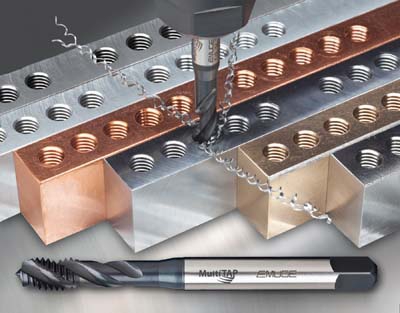
Emuge Corp. has announced the introduction of MultiTAP, a tap to cut a wide range of materials, including carbon steel, steel alloys, stainless steel, aluminum, cast iron, copper, brass and bronze. MultiTAP can also produce threads within both 2B and 3B classes of fit, eliminating the guesswork of calculating H-limits. MultiTAP is for a job shop or a manufacturer that works with short- and medium-run threading applications across a wide spectrum of materials. To create the tool, Emuge design engineers choose a select base material, along with a special cutting/flute geometry and a surface treatment that would work in as many common materials and applications as possible. MultiTAP is constructed of a proprietary grade of HSS (HSS-E), Nitrided with a Ne2 surface treatment. It is available in both spiral point and spiral flute configurations for through- or blind-hole applications. Tap sizes cover a full range for UNC or UNF threads, from #4-40 to ¾"-16 in inch sizes, to metric sizes from M4 x 0.7 to M16 x 2.0.
Contact Details
Related Glossary Terms
- alloys
alloys
Substances having metallic properties and being composed of two or more chemical elements of which at least one is a metal.
- blind-hole
blind-hole
Hole or cavity cut in a solid shape that does not connect with other holes or exit through the workpiece.
- high-speed steels ( HSS)
high-speed steels ( HSS)
Available in two major types: tungsten high-speed steels (designated by letter T having tungsten as the principal alloying element) and molybdenum high-speed steels (designated by letter M having molybdenum as the principal alloying element). The type T high-speed steels containing cobalt have higher wear resistance and greater red (hot) hardness, withstanding cutting temperature up to 1,100º F (590º C). The type T steels are used to fabricate metalcutting tools (milling cutters, drills, reamers and taps), woodworking tools, various types of punches and dies, ball and roller bearings. The type M steels are used for cutting tools and various types of dies.
- tap
tap
Cylindrical tool that cuts internal threads and has flutes to remove chips and carry tapping fluid to the point of cut. Normally used on a drill press or tapping machine but also may be operated manually. See tapping.
- threading
threading
Process of both external (e.g., thread milling) and internal (e.g., tapping, thread milling) cutting, turning and rolling of threads into particular material. Standardized specifications are available to determine the desired results of the threading process. Numerous thread-series designations are written for specific applications. Threading often is performed on a lathe. Specifications such as thread height are critical in determining the strength of the threads. The material used is taken into consideration in determining the expected results of any particular application for that threaded piece. In external threading, a calculated depth is required as well as a particular angle to the cut. To perform internal threading, the exact diameter to bore the hole is critical before threading. The threads are distinguished from one another by the amount of tolerance and/or allowance that is specified. See turning.







